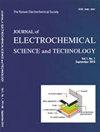UV-cured Polymer Solid Electrolyte Reinforced using a Ceramic-Polymer Composite Layer for Stable Solid-State Li Metal Batteries
IF 3
4区 工程技术
Q3 ELECTROCHEMISTRY
Journal of electrochemical science and technology
Pub Date : 2023-01-05
DOI:10.33961/jecst.2022.00829
引用次数: 0
Abstract
In recent years, solid-state Li metal batteries (SSLBs) have attracted significant attention as the next-generation batteries with high energy and power densities. However, uncontrolled dendrite growth and the resulting pulverization of Li during repeated plating/stripping processes must be addressed for practical applications. Herein, we report a plastic-crystal-based polymer/ceramic composite solid electrolyte (PCCE) to resolve these issues. To fabricate the one-side ceramic-incorporated PCCE (CI-PCCE) film, a mixed precursor solution comprising plastic-crystal-based polymer (succinonitrile, SN) with gar-net-structured ceramic (Li 7 La 3 Zr 2 O 12 , LLZO) particles was infused into a thin cellulose membrane, which was used as a mechanical framework, and subsequently solidified by using UV-irradiation. The CI-PCCE exhibited good flexibility and a high room-temperature ionic conductivity of over 10 -3 S cm -1 . The Li symmetric cell assembled with CI-PCCE provided enhanced durability against Li dendrite penetration through the solid electrolyte (SE) layer than those with LLZO-free PCCEs and exhibited long-term cycling stability (over 200 h) for Li plating/stripping. The enhanced Li + transference number and lower interfacial resistance of CI-PCCE indicate that the ceramic-polymer composite layer in contact with the Li anode enabled the uniform distribution of Li + flux at the interface between the Li metal and CI-PCCE, thereby promoting uniform Li plating/stripping. Consequently, the Li//LiFePO 4 (LFP) full cell constructed with CI-PCCE demonstrated superior rate capability (~120 mAh g -1 at 2 C) and stable cycle performance (80% after 100 cycles) than those with ceramic-free PCCE.用陶瓷-聚合物复合层增强光固化聚合物固体电解质用于稳定的固态锂金属电池
本文章由计算机程序翻译,如有差异,请以英文原文为准。
求助全文
约1分钟内获得全文
求助全文
来源期刊

Journal of electrochemical science and technology
ELECTROCHEMISTRY-
CiteScore
6.30
自引率
8.10%
发文量
44
期刊介绍:
Covering fields:
- Batteries and Energy Storage
- Biological Electrochemistry
- Corrosion Science and Technology
- Electroanalytical Chemistry and Sensor Technology
- Electrocatalysis
- Electrochemical Capacitors & Supercapcitors
- Electrochemical Engineering
- Electrodeposition and Surface Treatment
- Environmental Science and Technology
- Fuel Cells
- Material Electrochemistry
- Molecular Electrochemistry and Organic Electrochemistry
- Physical Electrochemistry
- Solar Energy Conversion and Photoelectrochemistry
 求助内容:
求助内容: 应助结果提醒方式:
应助结果提醒方式:


